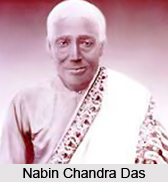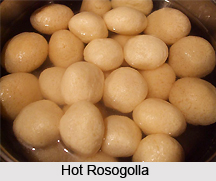 Nabin Chandra Das was not a confectioner. His progenitors were associated with the production of sugar. However, Nabin Chandra lost his father at a pre-natal stage and hence could not pursue the family trade. Financial stringency compelled him to abandon studies at a tender age and start a business. Success was very hard earned for him. After the initial hiccups in business, he set up a sweetmeat shop as his last resort in Baghbazar. Very soon, he came to realize that he had at last chosen the right metier.
Nabin Chandra Das was not a confectioner. His progenitors were associated with the production of sugar. However, Nabin Chandra lost his father at a pre-natal stage and hence could not pursue the family trade. Financial stringency compelled him to abandon studies at a tender age and start a business. Success was very hard earned for him. After the initial hiccups in business, he set up a sweetmeat shop as his last resort in Baghbazar. Very soon, he came to realize that he had at last chosen the right metier.
In a short while, Nabin, the undisputed King in the kingdom of sweets discovered that `Sandesh`, though very tasty, was getting stuck in the throats of many owing to its dryness. So, the great improviser started thinking of some new sweetmeat sans the dryness but more palatable and juicy. Initially, he found it impossible to pressure the shape of casein soaked in sugar-syrup with its taste intact. His experiments went on unabated but every time, this ball of sweetmeat started to dissipate and could not be kept as a tight round mass as intended.
Now this dispersed sweetmeat with a little touch of `class` became popular as `Baikuntha Bhog` and won the hearts of the sweet-lovers. However, Bengali cuisine had taken some giant steps ahead during these experiments and trials and at long last, the much-desired round ball of casein, soaked in syrup, came into being. Nabin Chandra Das named it `Rosogolla`. The Baghbazar of Roop Chand and Mohan Chand was shot into limelight for this sweet of incomparable delicacy. This prized sweet is pure milk casein processed and preserved in sugar-syrup. It is highly nutritious and can be digested easily. It should not be eaten at one go but in slices and the excess of syrup should be squeezed out before eating.
 Initially, Rosogolla did not evoke much response. The ordinary man did not like the sweetmeat of casein as they were granulated. One day Bhagwandas Bagla, an opulent businessman, stopped at Nabin Chandra`s shop while driving by. His child was thirsty. Bagla asked the helper-boy of Nabin`s shop to fetch a glass of water. As was the custom, the boy offered sweetmeat along with water. It was the special `Rosogolla` of Nabin Chandra`s shop served on a dish. Bagla`s child was delighted to taste this unique sweet. Seeing this, Bhagwandas Bagla himself tasted `Rosogolla` and was fascinated. Soon, the fame of this special sweet spread like wildfire and within a short span of 6/7 years, Rosogolla won the hearts of millions in and outside Bengal. Ironically, the orthodox society did not accept `Rosogolla` for a long time. They opined that a sweetmeat which was prepared by boiling, was not fit to be served to God for worship. Gradually, these negative thoughts and prejudices were eradicated and Rosogolla became a universal favourite.
Initially, Rosogolla did not evoke much response. The ordinary man did not like the sweetmeat of casein as they were granulated. One day Bhagwandas Bagla, an opulent businessman, stopped at Nabin Chandra`s shop while driving by. His child was thirsty. Bagla asked the helper-boy of Nabin`s shop to fetch a glass of water. As was the custom, the boy offered sweetmeat along with water. It was the special `Rosogolla` of Nabin Chandra`s shop served on a dish. Bagla`s child was delighted to taste this unique sweet. Seeing this, Bhagwandas Bagla himself tasted `Rosogolla` and was fascinated. Soon, the fame of this special sweet spread like wildfire and within a short span of 6/7 years, Rosogolla won the hearts of millions in and outside Bengal. Ironically, the orthodox society did not accept `Rosogolla` for a long time. They opined that a sweetmeat which was prepared by boiling, was not fit to be served to God for worship. Gradually, these negative thoughts and prejudices were eradicated and Rosogolla became a universal favourite.
Another ecstatic creation of Nabin Chandra was the ungranulated `Sandesh`, which was prepared with meticulous care after boiling for long. Some confectioners prepare such `Sandesh` without boiling much. Consequently, the sweets contain more proportion of liquid than desired, and the customers get deceived. But Nabin Chandra`s `Sandesh` was ungranulated and properly boiled. So it is devoid of the excess fluid, dry and very palatable. Some more of his outstanding creations are `Ratabi Sandesh`, `Abar Khabo` etc.




















